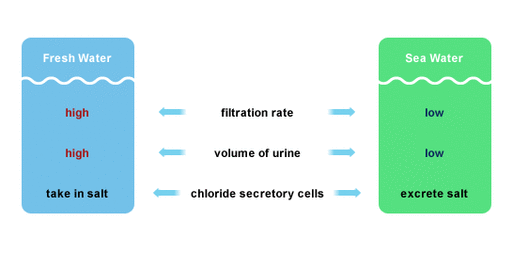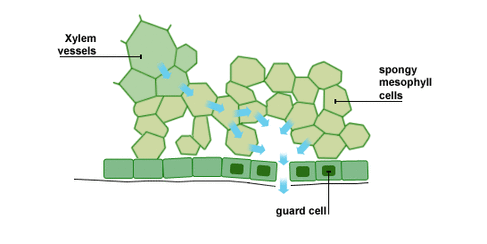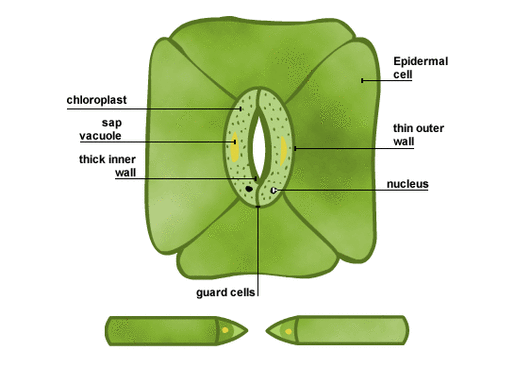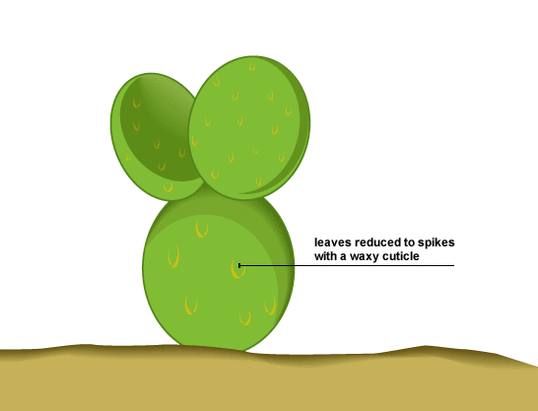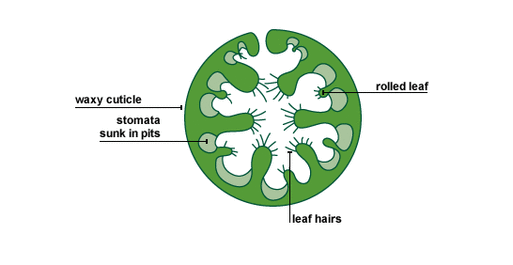Water balance in animals
Animals have physiological adaptations that allow them to maintain water balance. The example often given is the desert or kangaroo rat, which has dry mouth and nasal passages, long loops of Henle, high levels of ADH in its blood, an efficient large intestine and does not sweat. These adaptations allow the kangaroo rat to minimise water loss and maximise water reabsorption.
Animals may also demonstrate behavioural adaptations to limit water loss. The kangaroo rat will burrow underground where it is cooler during the day and is nocturnal – venturing out when conditions are cooler at night.
Animals have physiological adaptations that allow them to maintain water balance. The example often given is the desert or kangaroo rat, which has dry mouth and nasal passages, long loops of Henle, high levels of ADH in its blood, an efficient large intestine and does not sweat. These adaptations allow the kangaroo rat to minimise water loss and maximise water reabsorption.
Animals may also demonstrate behavioural adaptations to limit water loss. The kangaroo rat will burrow underground where it is cooler during the day and is nocturnal – venturing out when conditions are cooler at night.
Osmoregulation in fish
Because of their environment, osmoregulation in fish presents specific problems. Fish have adaptations that enable them to deal with these problems. Those which live in fresh water or sea water have different problems.
Freshwater fish
Problems:
Solutions:
Problems:
Solutions:
Because of their environment, osmoregulation in fish presents specific problems. Fish have adaptations that enable them to deal with these problems. Those which live in fresh water or sea water have different problems.
Freshwater fish
Problems:
- These fish are hypertonic to their surroundings. This means their blood has a lower water concentration than the surrounding fresh water.
- As fresh water passes through the mouth and over the gill membranes, water molecules diffuse from the fresh water into the blood by osmosis.
- These fish must produce a very large volume of urine to balance this large intake of water.
- This large volume of urine carries salt with it, and the salt has to be replaced.
Solutions:
- To produce a large volume of urine the fish must remove a large volume of water from the blood by having a high rate of filtration into the kidney tubules.
- This is done by having a kidney with many large glomeruli - capillary networks from which fluid is filtered at the start of the kidney tubules.
- Salt replacement is solved by chloride secretory cells in the gills, which actively transport salts from the surrounding water into the blood.
Problems:
- These fish are hypotonic to their surroundings. This means their blood has a higher water concentration than the surrounding sea water.
- As sea water passes through the mouth and over the gill membranes, water molecules diffuse out of the blood into the sea water by osmosis.
- These fish must replace the water which they constantly lose by osmosis
- They can also only afford to produce a very small volume of urine.
- Drinking sea water brings a large quantity of salt into the blood and this has to be removed.
Solutions:
- To replace the water they lose, saltwater fish drink sea water.
- To produce a small a volume of urine they must have a low rate of filtration of water into the kidney tubules.
- This is done by having a kidney with relatively few small glomeruli.
- Salt is removed by chloride secretory cells in the gills, which actively transport salts from the blood into the surrounding water.
Osmoregulation in salmon
Salmon begin their lives in rivers and migrate to the sea, returning to the same rivers later in their lives. They are able to cope with these changes by altering the way they osmoregulate.
Water balance in plants
Transpiration stream: First Stage
Transpiration stream: First Stage
Water taken up by the roots of a plant is transported through a plant to the leaves and lost into the air. The stages of the process are:
- Water enters root hair cells by osmosis.
- The root hair cell is hypertonic to the surrounding soil water. This means that it has a lower water molecule concentration.
- Water then moves from cell to cell through the root cortex by osmosis along a concentration gradient; this means that each cell is hypertonic to the one before it.
- In the centre of the root the water enters the xylem vessels.
- Water may move by diffusion through the cell walls and intercellular spaces.
Second Stage
In the leaves, water molecules leave the xylem vessels and move from cell to cell. They move through the spongy mesophyll layer by osmosis along a concentration gradient. Water then evaporates into spaces behind the stomata and diffuses through the stomata into the surrounding air.
Water rises from the roots to the leaves through the xylem vessels because of two properties of water molecules:
Water rises from the roots to the leaves through the xylem vessels because of two properties of water molecules:
- Adhesion
Water rises in the narrow vessels partly because water molecules are attracted to the walls of the vessels. - Cohesion
Water molecules are attracted to each other, and as water evaporates from the leaves columns of water are drawn up through the xylem vessels.
- it carries water for photosynthesis to the palisade cells in the leaves
- the water carries essential mineral salts in solution
- evaporation from the leaves has a cooling effect
Transpiration rate
The following factors affect the rate of transpiration:
The opening and closing of the stomata by the guard cells (stomatal rhythm)- In light, guard cells take up water by osmosis and become turgid. Because their inner walls are rigid they are pulled apart, opening the pore. In darkness water is lost and the inner walls move together closing the pore. Because of this, the transpiration rate is increased by an increase in light intensity.
Plants which live in extreme environments have adaptations to control their transpiration rate.
Xerophytes live in deserts where water is scarce and evaporation is rapid, or in windy habitats where evaporation can also be rapid. Their typical features are:
- The opening and closing of the stomata is controlled by the guard cells.
- In light, guard cells take up water by osmosis and become turgid. Because their inner walls are rigid they are pulled apart, opening the pore. In darkness water is lost and the inner walls move together closing the pore.
The opening and closing of the stomata by the guard cells (stomatal rhythm)- In light, guard cells take up water by osmosis and become turgid. Because their inner walls are rigid they are pulled apart, opening the pore. In darkness water is lost and the inner walls move together closing the pore. Because of this, the transpiration rate is increased by an increase in light intensity.
Plants which live in extreme environments have adaptations to control their transpiration rate.
Xerophytes live in deserts where water is scarce and evaporation is rapid, or in windy habitats where evaporation can also be rapid. Their typical features are:
- deep roots to reach water far underground
- shallow spreading roots to collect occasional rainfall
- leaves reduced to spines with minimum surface area for transpiration
- reduced number of stomata to reduce transpiration rate
- rolled leaves, leaf hairs and stomata sunk in pits to trap moist air, increasing humidity and slowing diffusion of water vapour from the stomata
- waxy leaf cuticle which is impermeable to water (preventing evaporation)
- stomata opening at night and closed at midday when evaporation rate would be highest (reversed stomatal rhythm).
- storage of water in succulent tissues
Example 1: Cactus
Example 2: Marram grass
Transpiration exam skills
Many questions ask you to explain observations on transpiration. Be sure to give full explanations rather than just descriptions.
Question
Describe the environment in which plants with sunken stomata are found and explain how this adaptation helps them to survive. (worth 2 marks)
Answer 1
They are found in dry habitats and the sunken stomata reduce water loss.
Receives 1 mark as it does not explain the process in full.
Answer 2
They are found in dry habitats. The sunken stomata trap moist air which reduces diffusion and reduces water loss.
Receives 2 marks as it goes on to explain the process in specific terms
Question
Explain why transpiration rate is reduced if humidity increases. (1 mark)
Answer 3
An increase in humidity reduces water loss from the leaves.
Receives no mark as it does not explain the process in full.
Answer 4
Transpiration rate fluctuates in relation to the rate of evaporation of water from the leaves. An increase in humidity reduces diffusion of water from the stomata, which results in a reduction in the rate of transpiration.
Receives 1 mark as it explains the process in specific terms.
Many questions ask you to explain observations on transpiration. Be sure to give full explanations rather than just descriptions.
Question
Describe the environment in which plants with sunken stomata are found and explain how this adaptation helps them to survive. (worth 2 marks)
Answer 1
They are found in dry habitats and the sunken stomata reduce water loss.
Receives 1 mark as it does not explain the process in full.
Answer 2
They are found in dry habitats. The sunken stomata trap moist air which reduces diffusion and reduces water loss.
Receives 2 marks as it goes on to explain the process in specific terms
Question
Explain why transpiration rate is reduced if humidity increases. (1 mark)
Answer 3
An increase in humidity reduces water loss from the leaves.
Receives no mark as it does not explain the process in full.
Answer 4
Transpiration rate fluctuates in relation to the rate of evaporation of water from the leaves. An increase in humidity reduces diffusion of water from the stomata, which results in a reduction in the rate of transpiration.
Receives 1 mark as it explains the process in specific terms.
